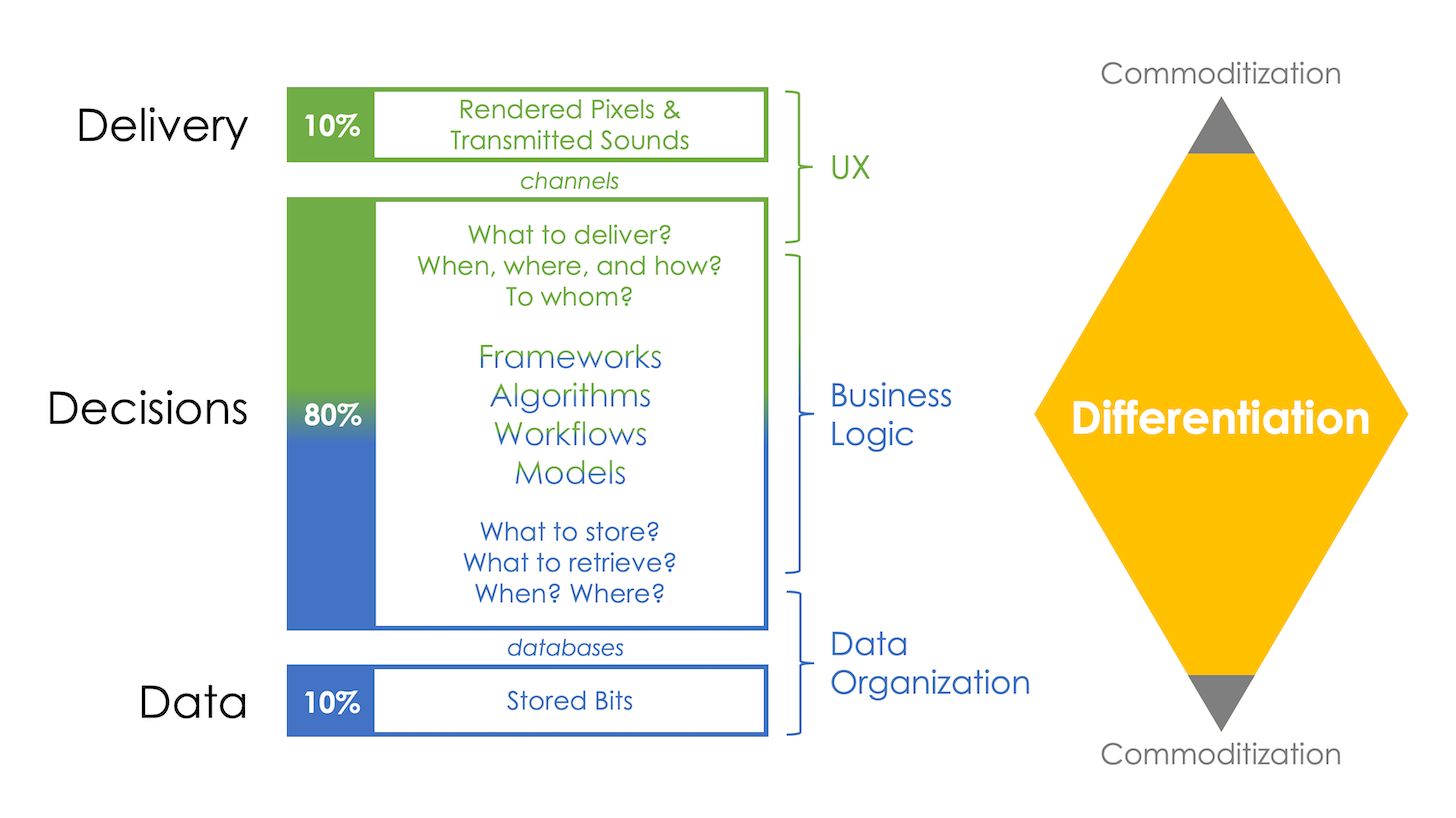Why there are 10,000 martech products that “kinda all do the same thing” (but not really)


1 of the perennial criticisms of the martech landscape is that “most of these goods all do the exact same issue.” Send an e-mail. Render a net web page. Evaluate some information. This criticism has developed louder in proportion to the development of the landscape.
With an more and more exasperated tone, people request, for example, “What’s the point of hundreds of CRMs or advertising automation applications? They are all just storing the identical purchaser fields and mail merging them into campaigns.”
I have commonly had two opposite responses to that accusation.
1st, I get a tiny defensive and say, “Hey, there are real innovations that transpire in martech all the time. For instance, you just can’t look at a item like DALL-E 2, that magically generates images from any description you can convey in phrases, and not take pleasure in that, wow, this truly is something new under the sunshine.”
But not all innovations in martech are that extraordinary. Coming up with the initially number of reverse ETL applications to conveniently (re)hydrate details into your app stack from your info warehouses was super helpful. But it was not worthy of a headline in The New York Occasions.
So, my fallback reaction is to admit, “Yeah, I guess you are proper. All electronic mail advertising and marketing tools kinda do the identical thing. But, hey, on the bright side, that kind of commoditized levels of competition amongst vendors should be good for you as a marketer. Laws of economics: it really should generate down your price tag.”
That normally mollified those critics, who largely just wished me to acquiesce to their intestine-stage perception that the martech landscape was all sound and fury signifying nothing at all. But it didn’t sit effectively with me. It didn’t feel to make clear the sheer volume of versions of items in martech types nor the enormous amount of mental funds that stored staying invested in them.
A few-Tier Architectures: Info, Conclusions, Supply
Let us start out by recognizing that most software follows a pattern of 3 tiers or levels:
- Facts — at the base: data saved in a database
- Presentation — at the top: what appears on the monitor to consumers
- Small business Logic — in the middle: selections and move concerning the other two layers
David Raab, the inventor of the CDP classification, mapped these to 3 stages of info, conclusions, and delivery. (I wrote an report past calendar year riffing on that product referred to as Info, Decisioning, Delivery & Style to distinguish CDPs from cloud information warehouses, CDWs.)
But these a few layers aren’t equal in scale or complexity.
The information layer looks intuitive as the easiest layer. If you’re speaking about purchaser documents, these kinds of as in CRM, there are typically a finite quantity of fields staying saved. And the most essential fields are normally the exact: name, company, title, e mail, phone range, handle, etc.
Of class, all consumer details isn’t solely that homogenized. Unique organizations acquire distinct data all over purchases, purchaser behaviors, demographic, firmographics, technographics, and so on. There can be relational knowledge connecting individuals prospects with strategies, method, and partners.
However, the quantity and dispersion of variation is modest. In other terms, the facts layer is pretty inclined to commoditization.

What about the presentation or delivery layer? Most people today — particularly UX pros — would say there is a good deal a lot more scale and complexity listed here. It’s anything that everybody sees or hears!
Intuitively, there is tremendous variation in presentation. Some interfaces are stunning other folks are unappealing. Some show you particularly what you want, wherever you want it other individuals are a very hot mess that your eyes painfully bushwhack by means of to come across the just one issue you were truly on the lookout for.
So presentation is an spot of differentiation, not commoditization, appropriate?
Really, no.
Forgive me for finding a little bit philosophical here, but have confidence in me, there is a significant position to it.
The specialized layer of presentation is actually relatively constrained. There are only so a lot of pixels, of so several hues, that you can put on a display screen. I’m not conversing about what all those pixels represent — that is one thing different, which we’ll get to in a second. The uncooked pixels and their typical designs veer in direction of commodities.
For that issue, if we extend over and above just “presentation” to protect other facets of “delivery” — how that presentation really comes in front of somebody — that is pretty commoditized way too. The HTTPS protocol for internet webpages. The SMTP protocol for e mail. The SMPP protocol for text messages. These are not just commodities, they are benchmarks.
Now ahead of designers start out sending me anatomically unflattering wireframes of the place I can stick this publish, allow me immediately observe up that style and design and UX are extremely complex and essential facets of goods and encounters that supply tremendous prospect for differentiation. (Look, I even place it in bold!)

But the magic and mastery of structure and UX is not in the delivery. It is in the selections about what to supply — when, the place, how, to whom.
It is the conclusions in UX that build differentiation.
Decisions Are the Wellspring of Differentiation
Most of computer software is decisioning. All these guidelines operating as a result of processors selecting if this, then that, tens of millions of periods per moment. The the vast majority of code in applications is “business logic”, a huge ocean between the seabed of prevalent details and the rather slim waves of presentation delivered on the floor.
The scale of the selections layer in software package is enormous. I’ve drawn it as 80%, relative to 10% for details and 10% for shipping and delivery, in my diagram. But it’s in all probability closer to 98% vs. 1% and 1% in most purposes.

It is also advanced. And I signify “complex” in the scientific perception of several interacting elements — and not just isolated inside of that a person application itself. The decisions one computer software application would make are impacted by the choices other linked software program apps make. In a stack of dozens of applications, hundreds of info sources, and countless numbers or hundreds of thousands of users, all feeding distinct inputs into a program’s selection-earning, you have an astronomical established of possibilities.
It’s in this complicated setting in which different software package apps carry to bear different algorithms, frameworks, workflows, and products to make conclusions in distinctive means.
There are three significant factors about this choices layer:
- It is the largest portion of what composes a computer software app.
- Collectively, there’s a around infinite amount of unique probable decisions.
- These conclusions can have important, material impact on business results.
The very last place need to be self-evident. Organizations compete on the selections they make. If you do not believe you can make distinct — much better — conclusions than your competitors, you need to likely consider a career as a airtight monk. (Ironically, a quite differentiated conclusion to make.)
The selections layer in application is a significant canvas for differentiation. And with its possible effects on outcomes, it’s a significant canvas for significant differentiation.
Just about no two program apps — at least applications of any considerable measurement — are the same.
Martech: Commoditized and Differentiated
When you appear at the higher-amount categories of the martech landscape, such as a big bucket for CRM, with hundreds of logos, it’s good to say that, positive, in some wide feeling, all people applications are the identical. They are all for buyer romantic relationship management.

You could also rightfully say that the details saved in all those CRMs are normally fairly equivalent far too. As are the supply channels in which they serve up presentation to workers back again-phase and consumers front-stage. By people lenses, they are commoditized items.
But the gigantic mass of conclusions in every single of these diverse CRMs may differ enormously.
Shell out some time applying HubSpot (disclosure: wherever I perform), Microsoft Dynamics, and Salesforce, and you will recognize just how different these CRMs are. Definitely for your experience as a consumer. But from the myriad of issues that contribute to differentiated experience for you in all those CRMs springs a fount of distinctive organization choices and buyer interactions.
Is just one certainly much better than the some others? (I’ll resist my personalized bias in answering that.) Offered the broad adoption of all 3, you have to conclude that the respond to to that concern is unique for various organizations.
(Sure, it’s a meta-selection to make a decision which decisions bundled in a CRM system you prefer, to help you make greater conclusions for your shoppers, to then assist them make far better choices in their companies, and so on. Turtles all the way down? Nope, it’s selections all the way down.)
And it is not just people a few CRMs. It’s the hundreds of some others. Each individual 1 formulated by diverse people today bringing various suggestions, philosophies, frameworks, and implementation possibilities to the large quantity of selections embedded in their product or service. All of which ripple into distinctions for how your enterprise will actually work in zillions of very small ways… but which mixture into not-so-little variances.
Far more colloquially, this is referred to as opinionated program.
Now, not all those discrepancies will be excellent types. It is a Darwinian market place for absolutely sure. Some CRM platforms will prosper other people will go extinct. New CRM startups will sprout with new versions. More than time, there may well be additional or fewer. But there is house for diverse CRMs with distinct choice layers to legitimately exist, as extended as each and every just one has a customer foundation — even if, or probably particularly if, it’s a area of interest — who choose the distinctive decisions of that seller.
This dynamic is current throughout all classes in martech.
Incremental Innovation Is Still Innovation
Now, are the differences in the choices layer in between two martech products in the similar group breakthrough, leap-frogging improvements?
Admittedly, most of the time, no. They are more usually “incremental innovation” — getting greater techniques to do some thing, not so significantly developing entirely new somethings. But it would be a mistake to disdain, “Pffft, that’s only incremental innovation.”
Incremental innovation is even now innovation. It can meaningfully differentiate just one seller from a different and supply fantastic advantages to their buyers.
This why martech has 10,000 goods that all kinda do the very same issue — but not genuinely.








